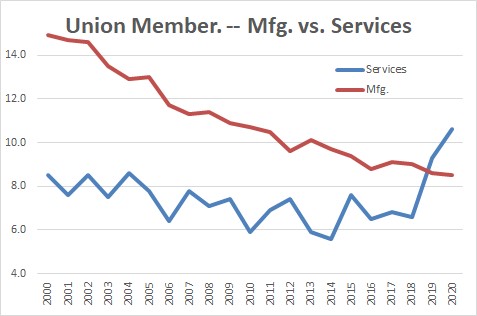February 3, 2021
Union membership has declined considerably from 13.1% in 2000 to a low of 10.3% in 2019. However, it climbed to 10.8% in 2020 as the pandemic-triggered recession caused a big drop in largely non-union private sector jobs, while union member jobs in the public sector were hit far less hard. Thus, the recession caused the percentage of union jobs to increase in 2020.
Union membership has been on a steady decline since 1945 when roughly one-third of employed people belonged to unions. By 1983 when the Bureau of Labor Statistics began collecting data, there were 17.7 million union workers which represented 20.1% of the workforce. Today only 14.3 million workers are members of unions and that represents just 10.8% of the workforce.
There are a variety of reasons for this decline. Automation is high on the list, as many labor-intensive jobs have been replaced machinery. The shift in the economy from being manufacturing based to services is another. Unions have traditionally been strong in manufacturing with larger plants, and weaker in the service industry with much smaller firms. Indeed, in the mid-1970’s the manufacturing sector represented 25% of the U.S. economy. Today manufacturing jobs are just 9% of the total. Also, many traditional union jobs have been shifted overseas to take advantage of lower wages. Having said all that, it appears that the unions gained some ground in the service sector in the past two years. In 2019 the percentage of workers that were members of unions rose from 6.6% to 9.3%, and then in 2020 it climbed further to 10.6% although — as noted earlier — the gain in that year was biased upwards by the recession. The unions appear to have gained some ground in the heavily union-dominated protective services industry, and also made some headway in organizing health care support workers.
Union membership is under attack from a number of different states and cities as those governors and mayors have figured out they simply cannot afford to pay for gold-plated benefits packages that the unions successfully negotiated in days gone by. The movement away from unions started in Indiana in 2012 but spread to Michigan in 2013 and Wisconsin in 2015. Michigan was a huge blow for union leaders because it is generally regarded as the birthplace of the modern labor movement. In 2016 West Virginia became another right to work state followed by Kentucky in 2017. In all, there are now 27 right-to-work states.
Stephen Slifer
NumberNomics
Charleston, SC



Follow Me